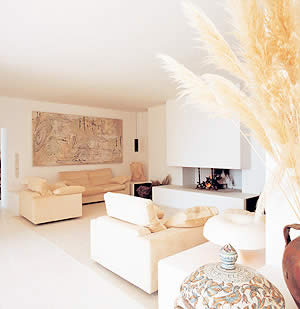
Interior Paint, White Paint
The winning ways of whites.
Usually grouped with other neutrals — black and gray — that don’t have a place on the color wheel, white is not always without color, of sorts. In fact, most whites aren’t pure white.
by Susan M. Brimo-Cox
No, these are not romanticized weather reports; they’re names of some of the many shades of white you can use to give the interior or exterior of a home pizzazz.
That’s right — white! In a world full of color, shades of white play an important role.
Usually grouped with other neutrals — black and gray — that don’t have a place on the color wheel, white is not always without color, of sorts. In fact, most whites aren’t pure white. Many have warm or cool undertones of color, such as soft blue, yellow, red or green. Don’t confuse these “off-whites” with pastels, which are definite hues. Rather, off-whites have just the barest hint of color. Barbara Richardson, director of color marketing at ICI Paints in Cleveland, describes them as “echoes,” versus “yelling” in, say, bright red. Considering all the paint manufacturers out there, you can easily see how there are hundreds, if not thousands, of shades of whites available. But don’t let that confuse you or create unnecessary problems. Off-whites, like hues, have their uses and there are tried-and-true methods to narrow the selection.
“Off-whites have been and will remain popular as a decorating color,” reports Andrea Piontek, color stylist with PPG in Pittsburgh. “Approximately 80 percent of all paint sold is a white or off-white. To the end user, ‘white’ is considered a ‘play-it-safe’ color that is acceptable in all types of decorating schemes…”
“Off-whites, especially the palest, warm tones, are the most popular paint colors,” says Emily Koch, director of marketing at Coronado Paint in Edgewater, Florida. “They are popular because they are light enough to not make a color statement and neutral enough to fit any scheme. Off-whites are good for backgrounds against other colors without adding impact to a room.”
White and off-whites have traditionally been used liberally indoors and out, either as the main color or as the accent and trim color. They can help set off color or they can add relief to strong colors. For example, if you wanted to paint a room a bold color, off-white trim and ceiling would provide the eye with some relief. Linda Trent, director of color and design marketing at Sherwin-Williams in Cleveland, explains, “Off-whites are like classical music and jazz standards. They are timeless, widely appealing and versatile, each one having its own color note.” “For exteriors, off-whites are a reliable choice because they don’t compete with neighboring houses, or with the colors of the landscape. A homeowner can still give their home a unique look by using bolder, more imaginative color selections on doors, shutters and other decorative elements,” says Trent.
Tina Ankeney, color design specialist at Dunn-Edwards in Los Angeles, suggests that in interiors there are three basic approaches to using whites: white walls with colored trim, colored walls with white trim or white walls with white trim. Each of these simple approaches offers distinct characteristics that are pleasing in multiple situations. One trend in particular she notices is “tinted white walls with mid-value color on trim and architectural moldings.”
“Using two different sheens and alternating them — such as, flat with semi-gloss stripes — can add some subtle interest,” observes Mary Lawlor, color stylist with Kelly Moore Paints in San Carlos, California. “Not everyone in the world likes color. They may be more comfortable adding color with accessories.”
Another way to “infuse creativity into the use of off-whites is to use several distinct variations throughout a home, then establish a sense of connectivity by using one fairly clean white on trim throughout,” Trent says.
Whites are a good choice for small, dark rooms that need to feel light, bright and spacious. They are also good for busy spaces that need the impression of simplicity. And for those white ceilings, “to be creative, paint the ceiling a darker shade of off-white and the walls a lighter shade,” recommends Piontek. “This will give the room a warmer feeling.” |

